Michelangelo carved a number of works in Florence during his time with the Medici, but in the 1490s he left Florence and briefly went to Venice, Bologna, and then to Rome, where he lived from 1496-1501. In 1497, a cardinal named Jean de Billheres commissioned Michelangelo to create a work of sculpture to go into a side chapel at Old St. Peter’s Basilica in Rome. The resulting work – the Pieta – would be so successful that it helped launch Michelangelo’s career unlike any previous work he had done.
Michelangelo claimed that the block of Carrara marble he used to work on this was the most “perfect” block he ever used, and he would go on to polish and refine this work more than any other statue he created.
The scene of the Pieta shows the Virgin Mary holding the dead body of Christ after his crucifixion, death, and removal from the cross, but before he was placed in the tomb. This is one of the key events from the life of the Virgin, known as the Seven Sorrows of Mary, which were the subject of Catholic devotional prayers. The subject matter was one which would have probably been known by many people, but in the late fifteenth century it was depicted in artworks more commonly in France and Germany than in Italy.
This was a special work of art even in the Renaissance because at the time, multi-figured sculptures were rare. These two figures are carved so as to appear in a unified composition which forms the shape of a pyramid, something that other Renaissance artists (e.g. Leonardo) also favored.
An examination of each figure reveals that their proportions are not entirely natural in relation to the other. Although their heads are proportional, 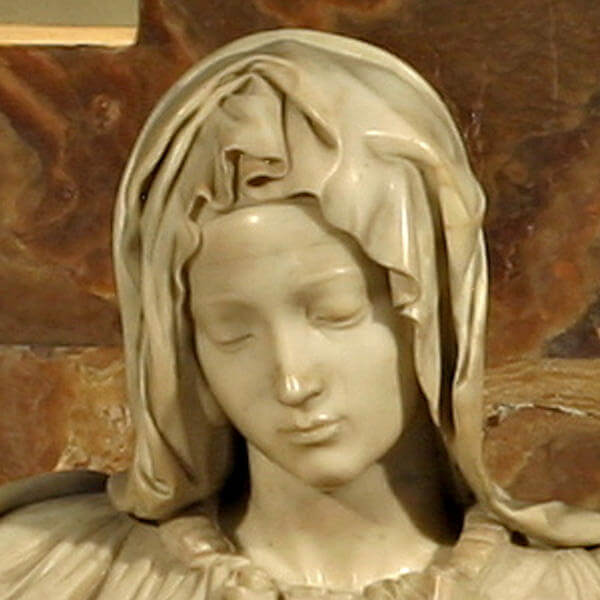 the Virgin’s body is larger than Christ’s body. She appears so large that if she stood up, she would likely tower over her son. The reason Michelangelo did this was probably because it was necessary so that the Virgin could support her son on her lap; had her body been smaller, it might have been very difficult or awkward for her to have held an adult male as gracefully as she does. To assist in this matter, Michelangelo has amassed the garments on her lap into a sea of folded drapery to make her look larger. While this drapery serves this practical purpose, it also allowed Michelangelo to display his virtuosity and superb technique when using a drill to cut deeply into the marble. After his work on the marble was complete, the marble looked less like stone and more like actual cloth because of its multiplicity of natural-looking folds, curves, and deep recesses.
the Virgin’s body is larger than Christ’s body. She appears so large that if she stood up, she would likely tower over her son. The reason Michelangelo did this was probably because it was necessary so that the Virgin could support her son on her lap; had her body been smaller, it might have been very difficult or awkward for her to have held an adult male as gracefully as she does. To assist in this matter, Michelangelo has amassed the garments on her lap into a sea of folded drapery to make her look larger. While this drapery serves this practical purpose, it also allowed Michelangelo to display his virtuosity and superb technique when using a drill to cut deeply into the marble. After his work on the marble was complete, the marble looked less like stone and more like actual cloth because of its multiplicity of natural-looking folds, curves, and deep recesses.
In her utter sadness and devastation, she seems resigned to what has happened, and becomes enveloped in graceful acceptance. Michelangelo’s talent in carving drapery is matched by his handling of the human forms in the Christ and the Virgin, both of whom retain a sweet tenderness despite the very tragic nature of this scene. This is, of course, the moment when the Virgin is confronted with the reality of the death of her son. In her utter sadness and devastation, she seems resigned to what has happened, and becomes enveloped in graceful acceptance. Christ, too, is depicted almost as if he is in a peaceful slumber, and not one who has been bloodied and bruised after hours of torture and suffering. In supporting Christ, the Virgin’s right hand does not come into direct contact with his flesh, but instead it is covered with a cloth which then touches Christ’s side. This signifies the sacredness of Christ’s body. Overall, these two figures are beautiful and idealized, despite their suffering. This reflects the High Renaissance belief in Neo-Platonic ideals in that beauty on earth reflected God’s beauty, so these beautiful figures were echoing the beauty of the divine.
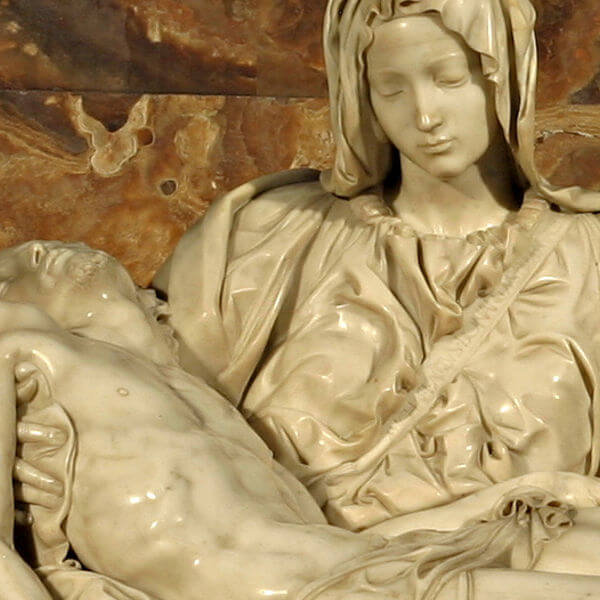 Around the time the work was finished, there was a complaint against Michelangelo because of the way he depicted the Virgin. She appears rather young – so young, in fact, that she could scarcely be the mother of a thirty-three-year-old son. Michelangelo’s answer to this criticism was simply that women who are chaste retain their beauty longer, which meant that the Virgin would not have aged like other women usually do.
Around the time the work was finished, there was a complaint against Michelangelo because of the way he depicted the Virgin. She appears rather young – so young, in fact, that she could scarcely be the mother of a thirty-three-year-old son. Michelangelo’s answer to this criticism was simply that women who are chaste retain their beauty longer, which meant that the Virgin would not have aged like other women usually do.
Another noteworthy incident after the carving was complete involves the inscription on the diagonal band running over the Virgin’s torso. Vasari tells us about the reason for this inscription in one of his passages about the life of Michelangelo:
Here is perfect sweetness in the expression of the head, harmony in the joints and attachments of the arms, legs, and trunk, and the pulses and veins so wrought, that in truth Wonder herself must marvel that the hand of a craftsman should have been able to execute so divinely and so perfectly, in so short a time, a work so admirable; and it is certainly a miracle that a stone without any shape at the beginning should ever have been reduced to such perfection as Nature is scarcely able to create in the flesh. Such were Michelagnolo’s love and zeal together in this work, that he left his name a thing that he never did again in any other work written across a girdle that encircles the bosom of Our Lady. And the reason was that one day Michelagnolo, entering the place where it was set up, found there a great number of strangers from Lombardy, who were praising it highly, and one of them asked one of the others who had done it, and he answered, “Our Gobbo from Milan.” Michelagnolo stood silent, but thought it something strange that his labors should be attributed to another; and one night he shut himself in there, and, having brought a little light and his chisels, carved his name upon it.
Vasari’s Lives of the Artists
This was the only work of Michelangelo to which he signed his name.
The Pieta became famous right after it was carved. Other artists started looking at it because of its greatness, and Michelangelo’s fame spread. Since the artist lived another six decades after carving the Pieta, he witnessed the reception of the work by generations of artists and patrons through much of the sixteenth century.
In more modern times, the Pieta has experienced some colorful events. In 1964, it was lent to the New York World’s Fair; afterwards, Pope Paul VI said it wouldn’t be lent out again and would remain at the Vatican. In 1972, a Hungarian-born man (later found to be mentally disturbed) rushed the statue with a hammer and started hitting it, including the left arm of the Virgin, which came off, and her head, breaking her nose and some of her left eye. Today, you can visit the statue in New St. Peter’s Basilica in Rome.
Further Reading
Michelangelo: The Complete Sculpture, Painting, Architecture, by William E. Wallace
Michelangelo: The Achievement of Fame, 1475-1534, by Michael Hirst
Michelangelo and the Reinvention of the Human Body, by James Hall

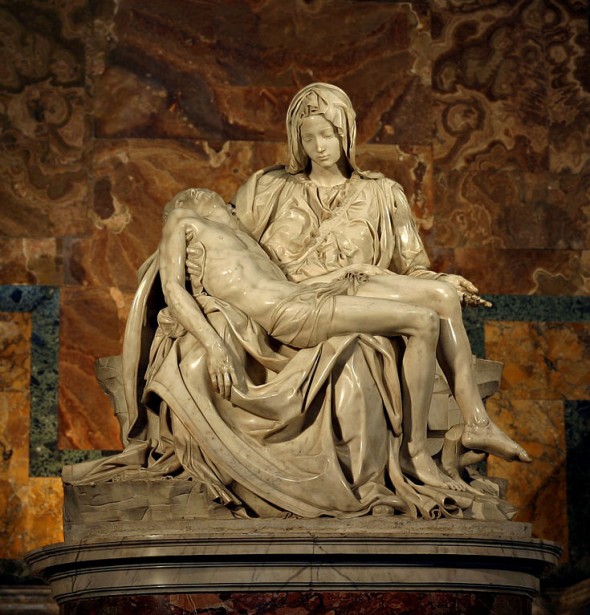

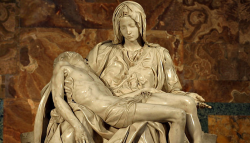
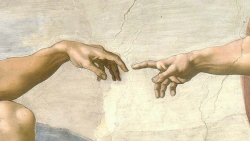
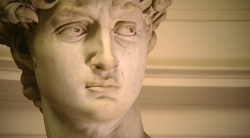
This information definitely helped me write up that art history paper on time. (I cited my sources, don’t worry.)
It’s “Carrera” marble not “Carrara”. Use spell check if you are going to post information online!!
Take a look at the first line of the relevant Wikipedia entry: “Carrara marble, sometimes mistakenly called Carrera marble, is a type of white or blue-grey marble popular for use in sculpture and building decor.”
It is actually Carrara Marble, Robert. Please research before you leave nasty comments.
It is called “Carrara marble” because it is from quarries in Carrara, Italy. 🙂
Pingback: Michelangelos Florence Pieta | Spotbooks.info
Pingback: Behind the Muse: with John Bell | Art Lotto
i saw this yrs ago when i was 8 in nyc for the worlds fair— i fell in love with it and the love has never passed away..it was lit so beautifully…a gasp escaped me.
There are photos somewhere of the statue in a crate being transported on a ship for that World’s Fair. I can’t imagine how much the statue would be insured for if the Vatican were to lend it out again.
I have a sculpture of the pieta my granmother gave to me the names on it says it was angelo an on the back another name A.Giannetti it very heavy.
I remember seeing the Pita when it came to the New York Worlds Fair. I was in high school then and of course thought I knew everything and no piece of sculpture could impress me. So I went to the Vatican showcase to see it.
I remember distinctly how quiet and dark it was when I entered. The only light was shining down over the head of Jesus’ mother , Mary. I stepped on to the moving staricase to go pass the sculpture and I remember being struck at the thought that even though it was marble, the statue seem to emanate the pain of a mother holding her dead son. I didn’t realize it but I had started to cry. It was just so sad to me. I’ve never forgotten it.
Thanks for your comment, Simone. It must have been something to see the Pieta in person outside of Italy.